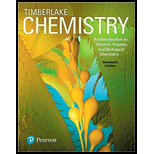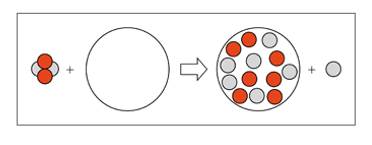
Chemistry: An Introduction to General, Organic, and Biological Chemistry (13th Edition)
13th Edition
ISBN: 9780134421353
Author: Karen C. Timberlake
Publisher: PEARSON
expand_more
expand_more
format_list_bulleted
Concept explainers
Textbook Question
Chapter 5, Problem 5.53UTC

5.53 Draw the nucleus of the isotope that is bombarded in the following: (5.2)

Expert Solution & Answer
Trending nowThis is a popular solution!

Students have asked these similar questions
4.82 For each of the following, write the symbol and name for X and the number
of protons and neutrons. Which are isotopes of each other? (4.4, 4.5)
a. 124x
A
47
b. 16x
116x
49
C.
50
d. 124x
50
116X
e.
48
11:11 ÔN A D
Instructions - Classes - C...
https://coetbschemfabon.neolm.
Fill in the blanks:
(4.1) Write the complete atomic/nuclide
symbol for (a) an ion fluoride that
contains 9 protons and 10 neutrons in
the nucleus and 10 extranuclear
electrons? (b) an ion of iron that
contains 26 protons and 30 neutrons
in the nucleus and 24 extranuclear
electrons?
Note: Use the "^" caret symbol to denote
exponential components..for
Ca¯“can be written as
example, 20
"20^40Ca^-2" (atomic number written
first).
Answer: (a) mass number
nuclide symbol
(b) mass number
nuclide symbol
Continue >
Status
Dause
The most prevalent isotope of gold is Au-197. (4.5)a. How many protons, neutrons, and electrons are in this isotope?b. What is the atomic symbol of another isotope of gold with 116 neutrons?c. What is the atomic symbol of an atom with an atomic number of 78 and 116 neutrons?
Chapter 5 Solutions
Chemistry: An Introduction to General, Organic, and Biological Chemistry (13th Edition)
Ch. 5.1 - Prob. 5.1PPCh. 5.1 - Prob. 5.2PPCh. 5.1 - Naturally occurring potassium consists of three...Ch. 5.1 - Naturally occurring iodine is iodine-127....Ch. 5.1 - Identify each of the following: a. 10X b. 24X c....Ch. 5.1 - Identify each of the following: a. 11X b. 3581X c....Ch. 5.1 - Prob. 5.7PPCh. 5.1 - Prob. 5.8PPCh. 5.1 - Prob. 5.9PPCh. 5.1 - Prob. 5.10PP
Ch. 5.1 - Prob. 5.11PPCh. 5.1 - Prob. 5.12PPCh. 5.2 - Prob. 5.13PPCh. 5.2 - Prob. 5.14PPCh. 5.2 - Prob. 5.15PPCh. 5.2 - Prob. 5.16PPCh. 5.2 - Prob. 5.17PPCh. 5.2 - Prob. 5.18PPCh. 5.2 - Prob. 5.19PPCh. 5.2 - Prob. 5.20PPCh. 5.2 - Complete each of the following reactions: a....Ch. 5.2 - Prob. 5.22PPCh. 5.3 - Prob. 5.23PPCh. 5.3 - Prob. 5.24PPCh. 5.3 - Prob. 5.25PPCh. 5.3 - Prob. 5.26PPCh. 5.3 - Prob. 5.27PPCh. 5.3 - Prob. 5.28PPCh. 5.4 - Prob. 5.29PPCh. 5.4 - Prob. 5.30PPCh. 5.4 - Prob. 5.31PPCh. 5.4 - Prob. 5.32PPCh. 5.4 - Prob. 5.33PPCh. 5.4 - Prob. 5.34PPCh. 5.5 - Prob. 5.35PPCh. 5.5 - Prob. 5.36PPCh. 5.5 - Prob. 5.37PPCh. 5.5 - Prob. 5.38PPCh. 5.5 - Prob. 5.39PPCh. 5.5 - Prob. 5.40PPCh. 5.6 - Prob. 5.41PPCh. 5.6 - Prob. 5.42PPCh. 5.6 - Prob. 5.43PPCh. 5.6 - Prob. 5.44PPCh. 5.6 - Prob. 5.45PPCh. 5.6 - Prob. 5.46PPCh. 5.6 - Prob. 5.47PPCh. 5.6 - Prob. 5.48PPCh. 5.6 - Prob. 5.49PPCh. 5.6 - Prob. 5.50PPCh. 5 - Prob. 5.51UTCCh. 5 - Prob. 5.52UTCCh. 5 - 5.53 Draw the nucleus of the isotope that is...Ch. 5 - Prob. 5.54UTCCh. 5 - Prob. 5.55UTCCh. 5 - Prob. 5.56UTCCh. 5 - Determine the number of protons and number of...Ch. 5 - Determine the number of protons and number of...Ch. 5 - Prob. 5.59APPCh. 5 - Prob. 5.60APPCh. 5 - Prob. 5.61APPCh. 5 - Prob. 5.62APPCh. 5 - Prob. 5.63APPCh. 5 - Prob. 5.64APPCh. 5 - Prob. 5.65APPCh. 5 - Prob. 5.66APPCh. 5 - Prob. 5.67APPCh. 5 - Prob. 5.68APPCh. 5 - Prob. 5.69APPCh. 5 - Prob. 5.70APPCh. 5 - Where does fusion occur naturally? (5.6)Ch. 5 - Prob. 5.72APPCh. 5 - Prob. 5.73APPCh. 5 - Prob. 5.74APPCh. 5 - Prob. 5.75APPCh. 5 - Prob. 5.76APPCh. 5 - Prob. 5.77APPCh. 5 - Prob. 5.78APPCh. 5 - Prob. 5.79CPCh. 5 - Prob. 5.80CPCh. 5 - Prob. 5.81CPCh. 5 - Prob. 5.82CPCh. 5 - Prob. 5.83CPCh. 5 - Prob. 5.84CPCh. 5 - Prob. 5.85CPCh. 5 - Prob. 5.86CPCh. 5 - Prob. 5.87CPCh. 5 - Prob. 5.88CPCh. 5 - Prob. 5.89CPCh. 5 - Prob. 5.90CP
Knowledge Booster
Learn more about
Need a deep-dive on the concept behind this application? Look no further. Learn more about this topic, chemistry and related others by exploring similar questions and additional content below.Similar questions
- Name the element that corresponds to each of the following:(5.4, 5.5, 5.6)a. 1s22s22p63s23p64s13d5b. [Xe]6s24f 145d106p5c. halogen with the highest ionization energy d. Group 2A (2) element with the lowest ionization energye. Period 4 element with the smallest atomic sizearrow_forwardConsider three elements with the following abbreviatedelectron configurations: (5.4, 5.5, 5.6)X = [Ar]4s23d5 Y = [Ar]4s23d104p1 Z = [Ar]4s23d104p6a. Identify each element as a metal, nonmetal, or metalloid.b. Which element has the smallest atomic size?c. Which element has the highest ionization energy?d. Which element has a half-filled sublevel?arrow_forward4.94 Indicate if each of the following statements is true or false: (4.3) a. The neutron has no net charges. b. Most of the mass of an atom is due to the protons and electrons. c. The total charge of the electrons is equal, but opposite, to the charge of the nucleus. d. The proton and the electron have about the same mass. e. The mass number is the number of protons. 4.10arrow_forward
- 4.121 Complete the following table: (4.3) Namere is ONE O tong of the Element bots he Magnesium Joghe amouse. The Atomic Symbolbo 80 Se 228 F 88 Ra Number of Protons 28 Number of Neutrons 34 14 Number of Electrons Avearrow_forward28. Completely describe the orbitals found in the fourth energy level. How many electrons can be found in a full fourth energy level? Give an example of an element that has its valence electrons in the fourth energy level. (3.3) K/Uarrow_forward4. If you were given an antique piece of jewelry and you were told that it was made of solid gold, how could you devise a test to indicate that it was actually made of gold? 6,7.5arrow_forward
- Part 2: Balancing Nuclear Reactions (5.2) 238 92U. 23Th + He 90 1. Identify the reactants and products in the above reaction. 2. For each element, what do the top (superscripted) and the bottom (subscripted) numbers represent respectively? 3. How many protons and neutrons are found in the uranium isotope used above? 4. How many protons and neutrons are found in the thorium isotope used above? 5. What is the difference in, a. the number of protons between U and Th? b. the number of neutrons between U and Th? c. the mass number between U and Th? 6. How do you explain these differences with respect to the nuclear reaction above?arrow_forwardThe table below is a summary of different modes of nuclear decay. Fill in the changes in atomic number (Z), number of neutrons (N), and mass number (A) in each case. Use “+” sign for increase, “–“ sign for decrease, and “0” for no change. Provide the symbol for each elementary particle involved in the decay process. (12 points) Decay Mode Particle Symbol Change in: Change in: Change in: Z N A Alpha decay 4/2α Beta decay 0/-1 β Positron decay 0/+1 β Electron capture 0/-1 earrow_forwardWrite the group number and draw the Lewis symbol for eachof the following elements: (5.6)a. barium b. fluorine c. krypton d. arsenicarrow_forward
- (8.2)Calculate the energy of the green light emitted, per photon, by a mercury lamp with a frequency of 5.49 x 1014 sec¹. O 3.64 x 10-19 J O 1.83 x 10-19 J O 5.46 x 10-19 J O 2.75 x 10-19 J O 4.68 × 10-19 Jarrow_forward(2.6) How many protons and electrons does phosphide ion (P3-) contains in its structure? protons [Choose ] electrons [Choose ] 4 Previous >arrow_forward5.96 a. Si b. Se c. Mn d. Sb Write the abbreviated electron configuration and group number for each of the following elements: (5.4) a. Br b. Rh c. Tc d. Raarrow_forward
arrow_back_ios
SEE MORE QUESTIONS
arrow_forward_ios
Recommended textbooks for you
 ChemistryChemistryISBN:9781305957404Author:Steven S. Zumdahl, Susan A. Zumdahl, Donald J. DeCostePublisher:Cengage Learning
ChemistryChemistryISBN:9781305957404Author:Steven S. Zumdahl, Susan A. Zumdahl, Donald J. DeCostePublisher:Cengage Learning ChemistryChemistryISBN:9781259911156Author:Raymond Chang Dr., Jason Overby ProfessorPublisher:McGraw-Hill Education
ChemistryChemistryISBN:9781259911156Author:Raymond Chang Dr., Jason Overby ProfessorPublisher:McGraw-Hill Education Principles of Instrumental AnalysisChemistryISBN:9781305577213Author:Douglas A. Skoog, F. James Holler, Stanley R. CrouchPublisher:Cengage Learning
Principles of Instrumental AnalysisChemistryISBN:9781305577213Author:Douglas A. Skoog, F. James Holler, Stanley R. CrouchPublisher:Cengage Learning Organic ChemistryChemistryISBN:9780078021558Author:Janice Gorzynski Smith Dr.Publisher:McGraw-Hill Education
Organic ChemistryChemistryISBN:9780078021558Author:Janice Gorzynski Smith Dr.Publisher:McGraw-Hill Education Chemistry: Principles and ReactionsChemistryISBN:9781305079373Author:William L. Masterton, Cecile N. HurleyPublisher:Cengage Learning
Chemistry: Principles and ReactionsChemistryISBN:9781305079373Author:William L. Masterton, Cecile N. HurleyPublisher:Cengage Learning Elementary Principles of Chemical Processes, Bind...ChemistryISBN:9781118431221Author:Richard M. Felder, Ronald W. Rousseau, Lisa G. BullardPublisher:WILEY
Elementary Principles of Chemical Processes, Bind...ChemistryISBN:9781118431221Author:Richard M. Felder, Ronald W. Rousseau, Lisa G. BullardPublisher:WILEY

Chemistry
Chemistry
ISBN:9781305957404
Author:Steven S. Zumdahl, Susan A. Zumdahl, Donald J. DeCoste
Publisher:Cengage Learning

Chemistry
Chemistry
ISBN:9781259911156
Author:Raymond Chang Dr., Jason Overby Professor
Publisher:McGraw-Hill Education

Principles of Instrumental Analysis
Chemistry
ISBN:9781305577213
Author:Douglas A. Skoog, F. James Holler, Stanley R. Crouch
Publisher:Cengage Learning

Organic Chemistry
Chemistry
ISBN:9780078021558
Author:Janice Gorzynski Smith Dr.
Publisher:McGraw-Hill Education

Chemistry: Principles and Reactions
Chemistry
ISBN:9781305079373
Author:William L. Masterton, Cecile N. Hurley
Publisher:Cengage Learning

Elementary Principles of Chemical Processes, Bind...
Chemistry
ISBN:9781118431221
Author:Richard M. Felder, Ronald W. Rousseau, Lisa G. Bullard
Publisher:WILEY
Atomic Number, Atomic Mass, and the Atomic Structure | How to Pass ChemistryThe Nucleus: Crash Course Chemistry #1; Author: Crash Course;https://www.youtube.com/watch?v=FSyAehMdpyI;License: Standard YouTube License, CC-BY